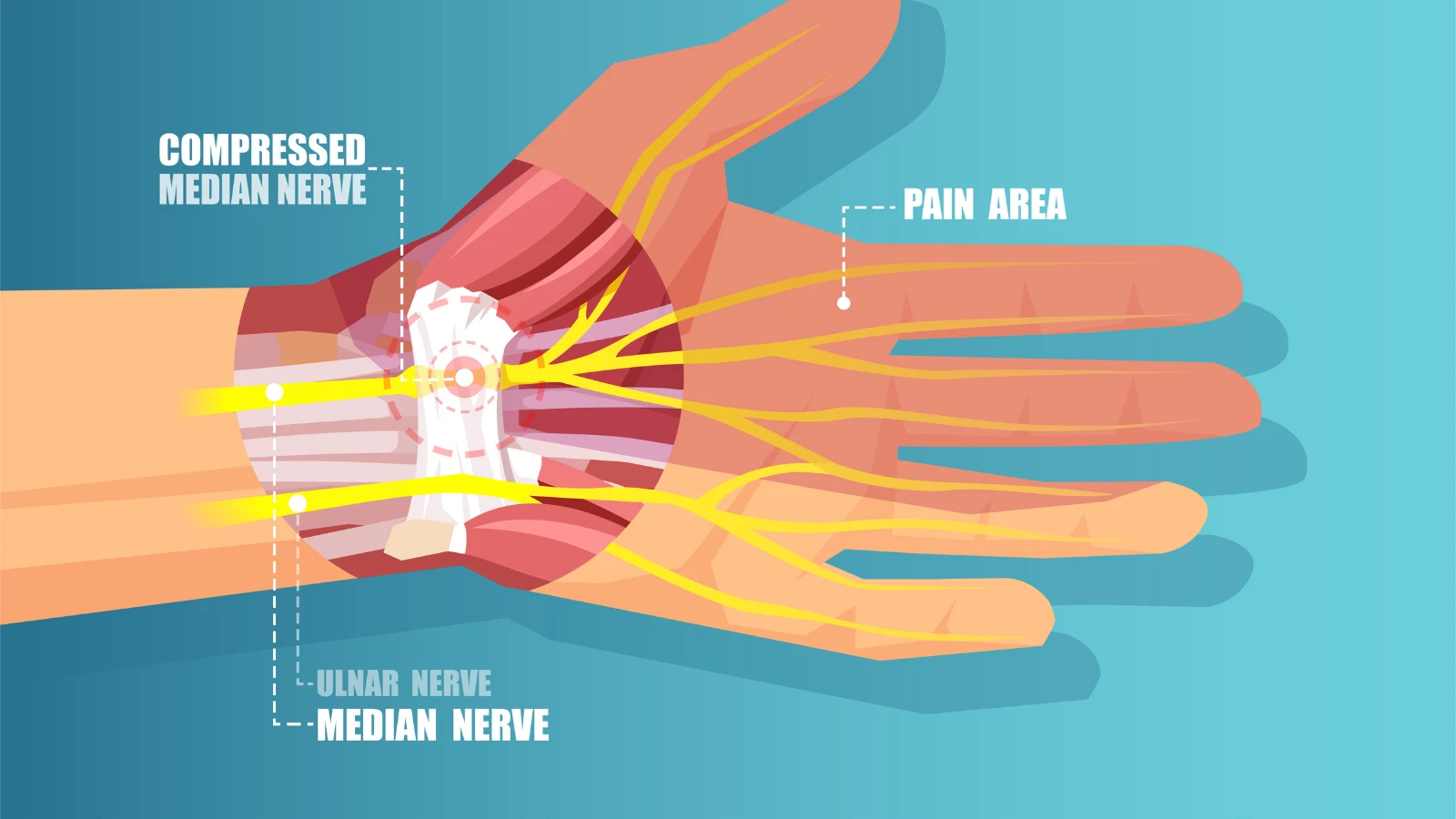Yoga for Healthy Wrists: Research Confirms Yoga is Effective for Carpal Tunnel Syndrome

Article At A Glance
Carpal Tunnel Syndrome (CTS) is a repetitive nerve compression wrist trauma that affects many people, especially in this computer age. Recent studies show that regular yoga practice can provide therapeutic benefits for CTS. The underlying message is that stretching, strengthening, relaxation, and awareness developed through yoga practice could be helpful in avoiding stress-related injuries.
As a neuroscience researcher, I have been involved in bench work activities for more than two decades. Routine laboratory work involves repetitive hand movements, tissue homogenization using handheld homogenizers, pipetting using handheld pipette aids, reagent and chemical preparations, and tabulating data (typewriters then and computers now). Call it luck or divine grace, but I have not suffered from any nerve compression in my wrists.
What is Carpal Tunnel Syndrome?

It is well established that repetitive finger and thumb motions with the hand flexed either down or up at the wrist cause carpal tunnel syndrome (CTS). Carpal tunnel syndrome is a painful condition of the wrist and hand that is caused by abnormal pressure on the median nerve. As the median nerve passes through the wrist and into the hand, it travels through a tunnel-like structure called the carpal tunnel. This tunnel is located on the thumb side of the palm. Within this tunnel lie tendons, ligaments, blood vessels, and the median nerve, all covered by a non-elastic tissue band called the transverse carpal ligament.
Repetitive motions exert excessive pressure on the ligaments and tendons that lie within the carpal tunnel. The ligaments and tendons respond to this excessive pressure by swelling. Since the covering of the carpal tunnel is non-elastic, it cannot expand. Therefore, the swollen structures press on the median nerve, often causing such great discomfort that individuals with CTS cannot perform their jobs.
Are You at Risk for Carpal Tunnel Syndrome?

According to the Mayo Clinic, the risk factors for CTS include:
- Anatomical Problems: Fracture, dislocation, or arthritis that damages the small bones in the wrist can alter the space within the carpal tunnel, adding excessive pressure on the median nerve.
- Gender: Since the carpal tunnel area is relatively smaller in women than in men, women are more susceptible to CTS.
- Chronic Conditions: Chronic illnesses, such as diabetes, obesity, inflammation, rheumatoid arthritis, or fluid retention, can increase the pressure within the carpal tunnel, affect the lining around the tendons and irritate the median nerve, resulting in damage to the nerve.
- Repetitive Movements: People who are most at risk for experiencing the symptoms of CTS include, but are not limited to, those who regularly perform these tasks: driving long distances, computer keyboard typing, using tools that produce vibrations in the hand, repetitive assembly line work, and continuous knitting and sewing.
Symptoms of CTS include tingling and numbness in the thumb, index and middle finger (median nerve distribution); burning, pain, and weakness in the fingers and hand; aching in the forearm that can radiate to the shoulder; and clumsiness or a weak grip. The numbness may become constant over time.
Treatment of CTS involves immobilizing the wrist in a splint to minimize or prevent pressure on the nerves. Patients are sometimes given anti-inflammatory drugs or injections of cortisone in the wrist to reduce the swelling. A small percentage of patients may also require surgery. Not only are the treatment procedures expensive, but these medical interventions have also met with mixed success, especially when the affected person resumes the same working conditions.
An Important Study Shows That Yoga Can Help

Many yoga positions involve deep stretching and, as such, could help with repetitive trauma disorders like carpal tunnel syndrome. A scientific study, Yoga-Based Intervention for Carpal Tunnel Syndrome, published in the prestigious Journal of the American Medical Association, concluded that, indeed, a yoga-based regimen is helpful in relieving CTS symptoms. This study was led by Dr. Marian Garfinkel, a senior Iyengar yoga teacher with over 30 years of experience.
The authors randomly divided 42 people with carpal tunnel syndrome into treatment and control groups. The control group received a splint to immobilize the joint. The treatment group practiced 11 yoga postures twice weekly for eight weeks. The postures were designed for strengthening, stretching, and balancing each joint in the upper body, along with relaxation.
After eight weeks, when the groups were tested to gauge the intensity of carpal tunnel syndrome, the group that practiced the yoga postures saw significant improvements in pain and grip strength, giving credence to the practice of yoga asanas in facilitating wrist healing and rejuvenation. Since CTS aggravates primarily with improper alignment, yoga asanas can prevent CTS by counteracting the repetitive movements that created the misalignments.
The underlying message is that stretching, strengthening, relaxation, and awareness developed through yoga practice could be helpful in avoiding stress-related injuries.
Reprinted with permission from Yoga for Healthy Aging Blog.
Ram Rao, Ph.D. With a doctorate in Neuroscience, Ram presently serves as a Research Associate Professor at the Buck Institute for Research on Aging. He focuses on various aspects of age-associated neurodegenerative diseases with emphasis on Alzheimer’s disease. In addition, Ram completed the academic training at the California College of Ayurveda (CCA) and received his certification as Clinical Ayurvedic Specialist. He has been a faculty of the California College of Ayurveda and teaches in their Nevada City location. Ram is also a dedicated Hatha yoga practitioner and is a Registered Yoga Teacher from Yoga Alliance USA. In his spare time, he offers consultations in YAMP techniques (Yoga, Ayurveda, Meditation & Pranayama). Ram has published several articles in major Yoga/Ayurveda magazines and has been a featured speaker in several national and international meetings and symposia. He is a member of the National Ayurvedic Medical Association (NAMA) and is on the Research Board of the Association of Ayurvedic Professionals of North America (AAPNA).




